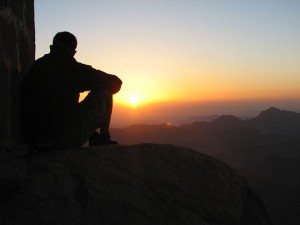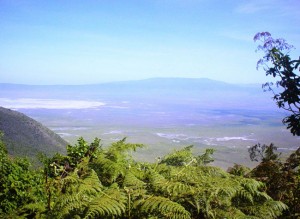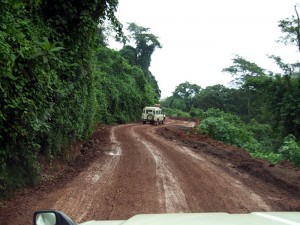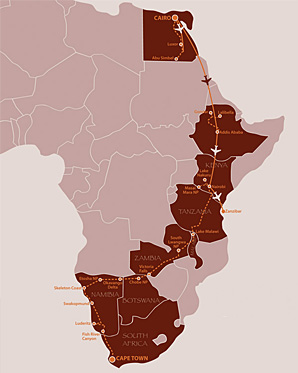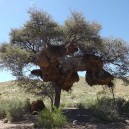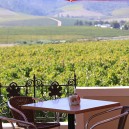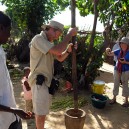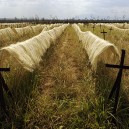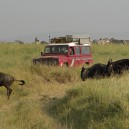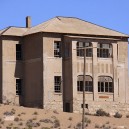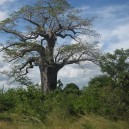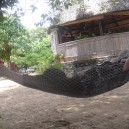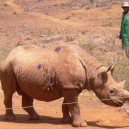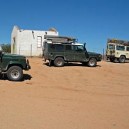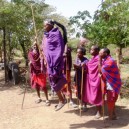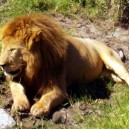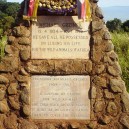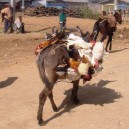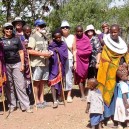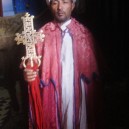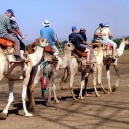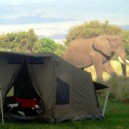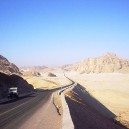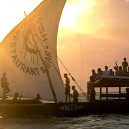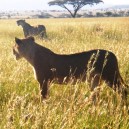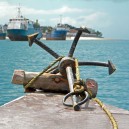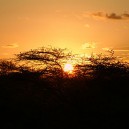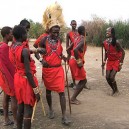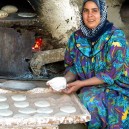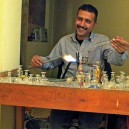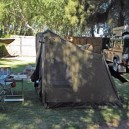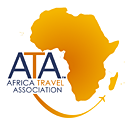Full-length Self Drive Safari Itinerary
(Click here for Cairo to Cape Town Safari tour details)
Week 1:
Upon arriving in Egypt you will be met by one of our representatives who will escort you to the hotel. If arriving early in the day the rest of the day is free to explore Cairo or relax and recover from your flight. The following 2 days are spent enjoying the great Pyramids, Sphinx, Temple of the Sun, Saqqara, Egyptian Museum and modern historic houses in Cairo. On one evening we enjoy the incredible Sound and Light Show at the Sphinx. Departing Cairo we board our flight to Aswan before making our way to Abu Simbel and exploring the magnificent monuments carved out of solid rock 3,000 years ago; built when Ramses II ruled as a tribute to his wife Nefertari. Returning to Aswan we settle in on our cruise boat before taking an afternoon felucca sail to gaze at the outside of Agha Khan Mausoleum and Elephantine Island.
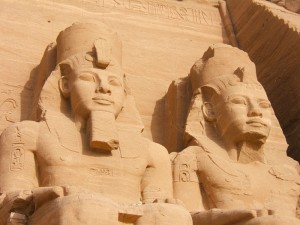
Abu Simbel is an incredible temple built by Ramses II in 1279 BC on the Nile not far from Aswan. The temple was moved rock by rock in 1964 to its present position to protect it from the rising waters of lake Nasser when Aswan High Dam was built.
We enjoy the sites of Aswan including High Dam and Philae Temple before setting sail for Kom Ombo. Arriving in the late afternoon we visit Kom Ombo temple dedicated to the crocodile god Sobek. Continuing to Edfu we visit the magnificent temple dedicated to the falcon headed god Horus. Onward we continue to Luxor, arriving in the late afternoon, we take a guided tour of Karnak and Luxor Temples. These temples will amaze you with all their grandeur and intricate hieroglyphics.
Week 2:
We spend most the day exploring the West Bank visiting world renowned sites Necropolis of Thebes, Colossi of Memnon, Queen Hatshepsut Temple and Valley of the Kings and Queens. We enjoy our final night in Luxor before returning to Cairo. Departing Egypt we fly to Ethiopia – to the country of dungeons and dragons!
Upon arriving in Ethiopia and transferring to our hotel we start our Ethiopian experience with a visit to the National Museum to see Lucy, 3.2 million year old human skeleton. We enjoy a visit to the Merkato (the largest open air market in Africa) and Holy Trinity Cathedral Church before making our way out of Addis Abeba to Mt Entoto where we have a panoramic view of the city from the top of the mountain.
WHAT OUR CUSTOMERS SAY…
I was very confused which Company to choose for my Africa Adventure, I had loads of brochures and travel agents were giving me all sorts of advice but no one could really answer all my questions until I found AES. It didn’t matter how many questions I asked each and every email was answered in detail and honestly. I booked my holiday with AES and had a fantastic time, the service from first enquiry to after the tour was unbeatable. Thank you for your patience and perseverance. I highly recommend traveling with Africa Expedition Support.
Departing Addis we fly to the lakeside town of Bahir Dar and the source of the Blue Nile. We take a boat trip to visit 14th century monasteries; some still in their original state before visiting the Blue Nile Falls. Our next stop is Gondar or rather the “Camelot of Africa” a short 3 hour drive from Bahir Dar through some of Ethiopia’s most stunning mountain landscape we arrive in the 17th century city. While in Gondar we visit the Royal Enclosure and King Fasiledes Bath, Debre Birhan Selassie displaying incredible murals, Qusqam church and Mentwab Palace.
Boarding our internal flight we make our way to Lalibella, perched at an altitude of 2630m above sea level, Lalibella remains a very isolated place and a center of pilgrimage. Famous for its 11 rock hewn churches built in one century with the help of Angels – so is the belief. The churches are maintained and guarded by priests and monks. A guided tour through these churches, religious or not, will leave you in awe.
Flying to Axum we spend the day visiting the Palace and tomb of King Kaleb, Stella’s filed, tomb of King Remhay, church of St Mary of Tsion in which the Arc of the Covenant is believed to be guarded and finally toward the late afternoon we visit lions carved from rock and the palace of the Queen of Sheba.
Week 3:
Returning to Addis Ababa we enjoy a final traditional meal before flying to Nairobi, Kenya and embarking on our next adventure; guided self drive expedition Nairobi to Cape Town. We swap our hotels and flight tickets for camping and car keys as we meet our Land Rover Defenders for the first time.
After taking care of formalities and acquainting ourselves with our 4WD vehicles we drive to the David Sheldrick Elephant Orphanage to experience first-hand some incredible conservation with orphaned elephants and hand feed endangered Rothschild Giraffes at the Nairobi Giraffe Centre. We pack our vehicles and head for the bush.
The Masai Mara National Reserve is even more stunning in real life than any documentary could possible portray. As the sun rises it reflects golden off the tips of the dry grass, as if this is nature’s alarm clock, the Masai Mara comes alive with activity. From morning to night this supreme game reserve will keep you in suspense wondering what animals you will see next from hyenas, cheetahs, elephants, gazelle, lions, impala, giraffe, buffalo, wildebeest, zebra, mongoose and the list continues.
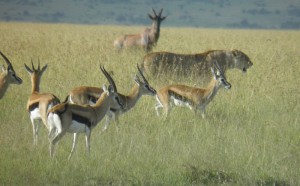
This lioness took all of us by surprise as she walked casually through a herd of gazelle and topi in the Masai Mara National Reserve
You really begin to feel like you are in Africa, behind the driving wheel and exploring the most famous game reserve in all of Africa.
Our next destination is Lake Naivasha and “Elsamere” – the home of Born Free where we indulge in high tea, watch a video about Joy Adamson’s life and visit a little museum dedicated to Joy and George. Before departing for Nakuru NP we take a gentle walking safari through Green Crater where, with our local guide, get pretty close to giraffe, warthog, eland, zebras, gazelle and flamingos.
Week 4:
Nakuru is a short 2 hour drive from the shores of Lake Naivasha. We arrive at Njoro and Kenana Farm, our home for the next 2 nights while we visit Lake Nakuru National Park. Lake Nakuru National Park is well known for its families of rhino gracefully “mowing” the sweet grass in the open plains near the Lake while thousands of pink flamingos elegantly drift, pelicans practice synchronized swimming while leopards overlook from the tall yellow acacia trees.
In the evening we return to Kenana Farm in awe of the spectacular sights we have seen. While at Kenana Farm we visit Kenana Knitters, an example of an excellent worthwhile and sustainable community project. On a guided tour we learn how this project runs, the benefits to the community and we get to show our support by purchasing some unique gifts.
We make our way back toward Nairobi but instead of spending the night back in a city we stay in a guest house on the edge of the Great Rift Valley in the heart of Masai Land; the base for Africa Expedition Support and community project Napenda Solar Community. The views are stunning and make a perfect spot to enjoy a sundowner and relax before continuing on our journey.
Amboseli National Park is our final destination in Kenya. Amboseli National Park is often overlooked but with perfectly clear views of Mt Kilimanjaro in the distance and African wildlife in the foreground it is hard to drive past without visiting.
Week 5:
Arriving in Tanzania our first town is Arusha not far from the border to Kenya and a major service town for Northern Tanzania. We are welcomed with open arms and wide cheesy smiles into a Masai village to explore and learn about this unique culture which has stood the test of time and western influences. Masai women are famed for their intricate beading skills and show off their hand made products at a local market where we can barter for jewelry and other items exclusive to this tribe.
For those after something very special Arusha is the main town dealing in Tanzanite. A blue diamond 100 times rarer than regular diamonds, only found in Tanzania makes this stone a very special souvenir or gift.
We leave the semi-arid area of northern Tanzania for the tropical island of Zanzibar on the Indian Ocean. Zanzibar will win your heart from the moment arriving, she is charming and exotic; it is hard to believe Zanzibar was once the “point of no return” for the lucrative slave trade. With the past in the past Zanzibar has grown to be a wonderful melting pot of many different cultures and religions where everyone is welcome.
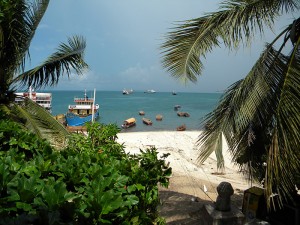
Zanzibar offers so much from historical walks, stunning beaches, brilliant diving, lovely resorts and exotic fruits. Or you can just sit back, relax and watch boats go by.
We are taken on a journey of discovery through the spice plantations and have plenty of free time to relax on the stunning beaches and sightsee in the historic town of Stone Town. One could spend days wandering the streets of the Old Town exploring places like the House of Wonders (Sultan’s Palace), The Palace Museum, old Fort, Persian baths and the old slave market.
Making our way back to the mainland we rejoin our vehicles and continue our expedition toward Malawi.
Week 6:
When planning a holiday to Africa very few tourists think to put Malawi on their list. What Malawi may lack in animal rich national parks she makes up for in the stunning lake, dramatic peaks and welcoming people. Malawi is often dubbed the “warm heart of Africa” a reflection of both her warm climate and friendliness.
Lake Malawi is the draw card, offering sandy beaches and clear blue waters; the vastness is overwhelming you will be forgiven for thinking you are sitting on the edge of the ocean. Aquatic enthusiasts and biologists come regularly to study and document rare and exotic fresh water tropical fish, some prehistoric species once thought extinct have been found alive and swimming in Lake Malawi. Diving and snorkeling are favorite activities along with sailing and canoeing; for land buffs this is perfect place to wander into villages, visit a school or clinic.
We divert from the lakes edge to venture into the highlands to visit the small town of Livingstonia built by Scottish missionaries in 1894 as a living tribute to Dr David Livingstone. Livingstonia feels more like a piece of Scotland rather than a Malawian town! To this day it is a fully functioning town boasting a university, hospital, church, secondary school and post office. The town is worthy a few hours to wander and gaze at the 19th century architecture, the church is particularly interesting with an intricate stained glass window depicting David Livingstone with 2 of his lifelong trusty aids Juma and Guze. The museum tells the fascinating story of early exploration and missionary work as well as home to a few items owned by David Livingstone.
Departing the Lake shores we head inland through Nkhotakota game reserve toward the border of Malawi and Zambia to South Luangwa National Park.
Until very recently South Luangwa NP was incredibly challenging to reach, one either had to fly or traverse one of the roughest and toughest dirt (sometimes mud) “road” in Zambia. After the Zambian President visited the area by road a couple of years he ordered it to be rebuilt. While the challenge of 4WDing to get to South Luangwa NP is now a mere fond memory for AES it has not impacted on the wild beauty of this stunning park.
South Luangwa NP is a very special game park, not only is it home to a number of mammals only found in the Luangwa valley but also allows day and night game driving. During the day we will seek out a variety of African wildlife from big cats to hippos to elephants to unique subspecies of zebra, wildebeest and giraffes. As the sun sets and the moon rises the park is alive with nocturnal animals like aardvark, zorilla, bush pigs, bushbaby, genet and if we are lucky we may spot a leopard or lion on the hunt!
Week 7:
Continuing on our journey through Zambia we stop for a brief visit in the capital Lusaka. Lusaka only a few years ago was a dusty under developed large town transformed by the sudden jump in copper prices (one of Zambia’s main exports) to a sophisticated city. The once broken tarred roads, crumbling buildings and lack of infrastructure is a now a thing of the past with wide multi-lane highways, international hotels and classy restaurants.
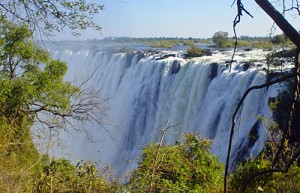
Nothing is more incredible than standing in front of The Victoria Falls and admiring this unbelievable natural creation bordering Zambia and Zimbabwe
Driving from Lusaka to Livingstone is exceptionally picturesque as we maneuver our way through small bustling towns and farming land toward Victoria Falls. Some days the spray of Victoria Falls can be seen from up to 50kms away, resembling smoke and how it got its name “the smoke that thunders”. The sight is truly remarkable as mist shoots hundreds of meters into the atmosphere created by the sheer pressure of millions of gallons of water being forced into a narrow gorge.
Arriving into Livingstone is like driving into a small Australian country town with historic building facades and wide tree lined avenues. We spend a few days in this quaint pleasant town, visiting the Victoria Falls and enjoying an array of various activities including flying high over the falls for an awestruck aerial view, trekking Rhino, walking with lions, jet boating and sunset cruise to mention a few.
Departing Zambia we take a ferry across to Botswana to explore Chobe National Park, Botswana’s finest game park. We discover this stunning area by land and water, an early morning game drive through the park and a late afternoon boat safari up Chobe River. Chobe NP is most famous for its elephant population having one of the highest concentrations in the World and it is on a boat safari we witness herds young and old enjoying a swim and a splash to cool off.
Leaving the common tourist route we travel through the Caprivi Strip in Northern Namibia. The Caprivi Strip is a narrow 280 mile stretch along northern Namibia nestled between Botswana, Zambia and Angola; it only exists due to slight oversight by the Germans who thought the Zambezi River would give them access from German South West Africa to the Indian Ocean, a key trading route. What they clearly forgot was Victoria Falls was a major stumbling block!
Nonetheless this region is as unique in history as it is in ecosystem providing a rich lush protected area for flora and fauna. The Kavango River feeds into the Okavango Delta providing a labyrinth of estuaries and lagoons where wildlife flourishes. We do not venture into the heart of the Okavango Delta preferring to stay on the periphery where there are facilities. We venture out on a motorized platform spotting numerous birds and aquatic life and game drive through Mahango Game Reserve in search of big game.
Week 8:
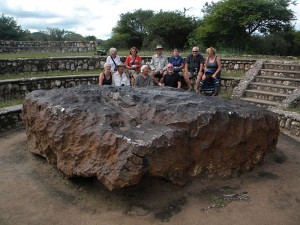
Hoba Meteorite in Namibia is the largest intact meteorite found in the world, weighing a staggering 66 tonnes it fell approximately 80,000 years ago and remained hidden until 1920
Making our way through Namibia we stop to visit the world’s biggest meteorite, not something one would expect! Driving through small country towns we arrive at the gates to Etosha National Park, Namibia’s no.1 game park. Etosha NP is an unusual park quite unlike anything we have experienced thus far, salt pans occupy majority of the region while semi-arid desert and wooded areas the rest. On first appearance it does not look like wildlife could not only survive in this area but thrive, however thousands of years of evolution has meant wildlife do exactly that. There are a few strategic waterholes scattered throughout the area and the perfect place to park up, enjoy some snacks and wait for the animals to come to you.
Etosha NP is where we bid farewell to African wildlife (with the exception of seals!) to take in some culture and history. Our history lesson begins 200 million years ago when the Petrified Forest was formed after conifers where uprooted by floods and swept down rivers; our local community guide gives us a fascinating tour on how and why this occurred as we stroll through the forest.
We are then taken to the early Stone Age where it is believed San hunters told stories of their lives, ceremonies, tribulations and defeats through rock art. Twyfelfontein, is home to an incredible 2,000 rock carvings, the most significant findings and depiction of early Africa. A tour of this area brings to life ancient cultures and rituals.
Continuing south along the Skeleton Coast we stop for a brief visit at one of the largest Cape Fur Seal colonies in the Southern Hemisphere at Cape Cross. This breeding colony attracts hundreds of thousands of seals ever year. However these are not true seals but Ear seals which is in fact a species of sea lion. These active vocal creatures will keep us entertained for a couple of hours.
Week 9:
As we continue along the Skeleton Coast to the seaside town of Swakopmund we pass shipwrecks many from bygone years. The Skeleton Coast was a treacherous body of water leaving many a seaman and ships in ruins over the centuries.
Swakopmund is a pleasant town with a very strong German influence; some say it is more German than Germany! The town is a leftover from the German colonization years complete with architecture and wide streets. It was only in the last couple of years that streets where renamed replacing their German names for local Namibian ones. For those with a sweet tooth it is hard to walk by one of the many German bakeries baking traditional tasty treats or a stein of beer at the local Brauhaus. Surrounded by desert sand dunes on one side and coast on the other, Swakopmund offers many activities for those who want to do more than just eat and drink! Deep sea game fishing, take a tour of the “living desert”, quad bike, dune buggy, sky diving and township tours are all on offer.
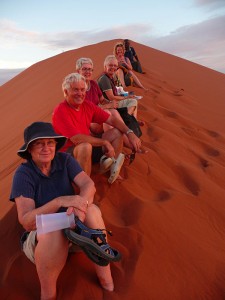
We huffed and puffed our way to the top of Dune 45, Sesrium in Namibia. It was tough but worth it for the amazing views from the top.
We drive back into the desert to Sesrium National Park and the magnificent Namib Dunes. Sesrium is a desert park protected due to the dunes fragile nature which are constantly shifting and moving. Although we may see the odd Oryx it is more likely we will see tracks of animals like the blind golden mole, “white lady” dancing spider and sidewinder adders. The most popular activity is to climb to the top of Dune 45, the world’s largest free standing sand dune at sunrise or sunset for the best sunburnt views over the desert.
From inland Namibia we make our way back toward the coast and continue our history lesson at Kolmanskop near Luderitz. Kolmanskop was a dynamic town established in 1908 after Zacharias Lewala, a railway worker, stumbled across a diamond and showed it to his supervisor. The town grew rapidly and flourished until 1954 when larger deposits were found elsewhere and Kolmanskop abandoned. This is a fascinating town as our guide explains how ice was made for lavish parties and cold drinks were served by the swimming pool. One cannot beat the desire to kick the ground a little just in case…..
Less than 50kms from Luderitz is the home to the wild Namib horses. There are many myths and legends about how these horses came to be living in harsh desert conditions. The most popular story is when the First World War ended the German soldiers could not bear to shoot their horses as ordered and instead let them go. These horses have thrived for many generations.
Week 10:
Taking dirt back roads we arrive at the edge of the world, Fish River Canyon. This is Africa’s equivalent to America’s Grand Canyon, an impressive 160km long, 27 km wide and 550m deep it has taken thousands of years to create this masterpiece. We spend some time sitting on the edge of the canyon overlooking the magnificent vista.
Crossing the border into South Africa and our final destination we make our way from dry sheep farming country toward the beautiful lush green fruit growing region of Citrusdale and finally Cape Town.
Cape Town, or Kaapstad, is by far the most cosmopolitan city in all of Africa and one of the most stunning in the World. In the afternoons a blanket of clouds roll over the edge of Table Mountain into the valley offering striking views from our hotel by the Waterfront. The position of Cape Town with its proximity to the meeting points of the Atlantic and Indian Oceans offers an eclectic mix of calm ocean bays and sensational surfing beaches.
Arriving at our hotel next to the V&A Waterfront we hang up our keys and venture into the wine region of Stellenbosch for a day of wine tasting and cheese sampling. In the evening we enjoy a group meal together at one of Cape Town’s outstanding restaurants. Having travelled from Cairo to Cape Town we feel both sad as the end is near and thrilled that we have achieved what many only dream of doing.

